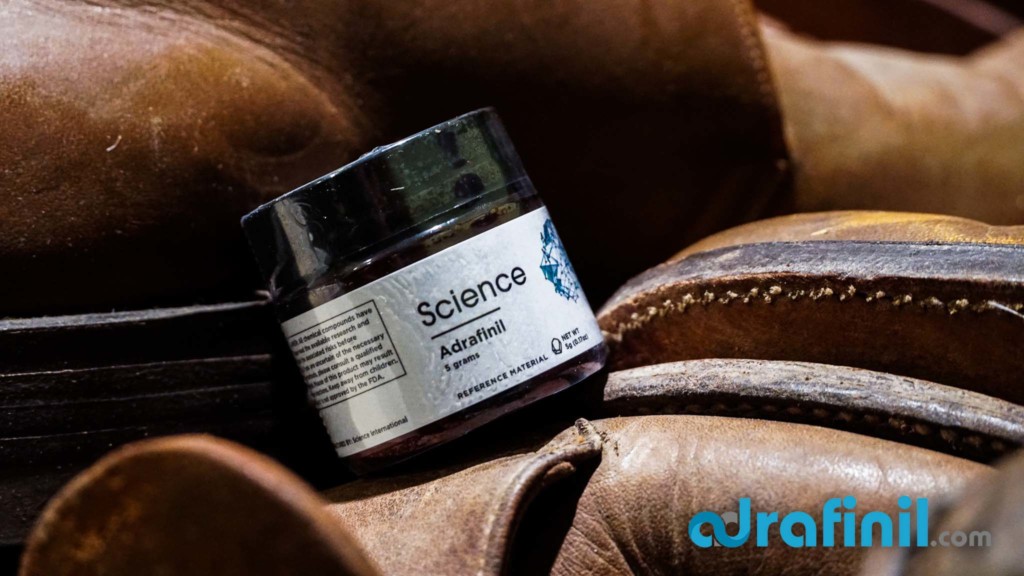Are you curious about adrafinil’s effects on the liver? If so, this guide will tell you what you need to know. Adrafinil is a “prodrug” of modafinil, meaning that it is converted (or metabolized) by the liver into modafinil and modafinil acid. This process places strain on the liver and can raise liver enzyme values—but by how much?
In this guide, we’ll explore adrafinil toxicity and explain its side effects and exactly how it affects the liver. Our sole aim for this guide is to give you an overview of this research nootropic’s impact on the liver so you can make an informed decision about dosage, study duration, and more.
Order Adrafinil online from the best vendor in the world!
Great prices, quick shipping, and guaranteed delivery.
Disclaimer: The contents of Adrafinil.com are for informational and educational purposes only. We do not provide legal advice. Likewise, we do not provide medical advice, diagnosis, or treatment. Please consult your physician prior to consuming Adrafinil or related nootropics. Your access to Adrafinil.com is subject to our full Disclaimer and Terms of Use.
What Is Adrafinil?
Adrafinil is a type of central nervous system stimulant known as an alpha-1 adrenergic agonist. It was discovered in 1974 by scientists working for the French pharmaceutical company Louis Lafon Laboratories (Lafon) [1].
Formally classified as a “eugeroic” (or “wakefulness-promoting agent”), adrafinil was found to be a “prodrug” of modafinil, a powerful dopamine reuptake inhibitor [2]. This means it is metabolized (converted) in the liver into its active metabolite, modafinil. Modafinil was first identified in 1976, and Lafon began developing both drugs, but it was adrafinil that showed early promise.
Animal studies indicated that adrafinil had a profound effect on the nocturnal activity of animals. A 1985 study by Milhaud CL et al found that adrafinil “doubled the nocturnal activity” of rhesus monkeys when administered at doses of 60 mg/kg [3].
Following several years of development and several successful clinical trials, adrafinil was released under the brand name “Olmifon” in 1985. Its main use was to treat elderly patients who suffered from age-related difficulties with vigilance. However, it was also shown to be beneficial for treating depression and was better tolerated than comparable substances such as clomipramine [1].
However, Lafon’s decision to introduce modafinil under the brand name “Modiodal” in 1994 marked the beginning of the end for Olmifon. Modiodal was significantly more potent and faster-acting than Olmifon, causing the older drug to fall into clinical disuse [3].
In the early 2000s, the US pharmaceutical company Cephalon acquired Lafon and continued to manufacture both adrafinil and modafinil [4]. However, following the publication of research that linked adrafinil to liver damage, the drug was discontinued in 2011 and the French authorities revoked its authorization.
What benefits might adrafinil offer?
Adrafinil’s main proven benefit is that it enhances alertness and vigilance in elderly patients. It has been tested using a double-blind study against a placebo and found to help treat age-related difficulties related to vigilance and depression.
Data from animal studies indicates that adrafinil may help increase performance motivation. A study published in 2000 by Siwak CT et al linked adrafinil to increased performance motivation in aging beagle dogs [5]; however, these results have yet to be tested in human clinical trials. Were adrafinil to produce this effect, it would be likely due to the action of its active metabolite, modafinil [6]. Research into modafinil has found that it offers cognitive neuroenhancement such as increased focus in healthy test subjects [7].
Some anecdotal evidence indicates that adrafinil is effective for enhancing athletic performance, likely due to its ability to enhance alertness and increase performance motivation. It was banned by the World Anti-Doping Organisation (WADA) in 2004, along with modafinil, indicating that both substances are beneficial to athletes looking to increase their performance [8].
Lastly, qualified nootropics researchers may benefit from adrafinil’s status as a research compound. While modafinil is typically available as a prescription drug, adrafinil is not classified as a prescription drug anywhere except in Australia, making it considerably easier to source within the Western world. In most countries, adrafinil is classified as a drug but is either unscheduled or uncontrolled and is available only as a reference material for researchers.

Adrafinil Side Effects and Safety
Compared with modafinil, which has been widely researched, there is limited available data from human trials into adrafinil’s side effects and safety. Olmifon product inserts stated that clinical trials had linked adrafinil to the following side effects [9]:
- Headaches,
- Stomach pains and gastric distress,
- Skin irritations and eruptions, and
- Inner tension (psychomotor excitation).
However, separate research has linked adrafinil to further side effects, including:
- Mania (in manic-depressive patients)
- Increase in alkaline phosphatases (with prolonged treatment)
- Orofacial dyskinesia, a condition that causes involuntary, repetitive movements of the face [10].
Adrafinil should not be administered to subjects who suffer from serious hepatic or renal disorders or epilepsy.
Adrafinil and Your Liver | What You MUST Know
One of the main reasons why adrafinil (Olmifon) was discontinued in 2011 was over concerns over its effect on liver function. Clinical trials found that adrafinil may elevate liver enzyme values if consumed in high doses for extended periods. This is because adrafinil is a liver-metabolized drug that is converted in the liver into an acid derivative (modafinil acid) and a glucuronic acid conjugation (modafinil). This process is known to raise liver enzyme values and is the primary reason why subjects with liver impairment should avoid adrafinil.
While findings from animal studies have indicated that adrafinil is non-teratogenic in animals, there is a lack of comparable data from human studies. Anecdotal evidence that we have examined suggests that adrafinil’s effect on liver enzyme values is not significant when taken at doses of 100-200 mg/day.
Is it safe to take adrafinil every day?
During the period when adrafinil was sold under the brand name Olmifon (1985-2011,) the recommended daily dose was 2-4 tablets (600-1,200mg). This indicates that adrafinil can be taken safely at this dose by subjects without preexisting liver conditions, under the supervision of a licensed practitioner or qualified researcher.
Subjects are advised to take liver function tests before and after participating in an adrafinil study, as research indicates that adrafinil places a strain on the liver.
Adrafinil should not be administered to any subject with any type of pre-existing kidney or liver problem or epilepsy.
Is adrafinil a dietary supplement?
No. The United States Food & Drug Administration (USFDA) classifies adrafinil as a drug “under section 201(g)(1)(B) and/or (g)(1)(C) of the Federal Food, Drug, and Cosmetic Act” [11]. While this act does contain an exception for certain foods that affect the structure and function of the body, adrafinil does not qualify for this exception, and is thus neither a dietary supplement nor conventional food.
As adrafinil has not received FDA approval, claims about its benefits, effects, side effects, or use have not been reviewed or authorized by the FDA. It cannot be lawfully marketed as a dietary supplement or described as such. At the time of writing, adrafinil is sold as “reference material” for use in experimental settings only.
How to Take Adrafinil Safely | 5 Quick Tips
As adrafinil was designed to treat a specific ailment that is not amenable to self-diagnosis (i.e. age-related difficulties with vigilance and mental clarity), treatment can only take place under the supervision of a licensed practitioner or researcher. Therefore, it is not possible to write adequate directions for a layperson to use adrafinil safely for its intended purpose.
However, based on medical literature, scientific research, and anecdotal evidence, the procedure for taking adrafinil can be outlined below.
1. Buy from a trusted source
As adrafinil is not FDA-approved and is not an over-the-counter (OTC) drug, it is not subject to the same regulations as prescription or OTC medications. Any claims made about adrafinil’s effectiveness have not been evaluated by the FDA and the manufacture of adrafinil is largely unregulated. Researchers interested in purchasing adrafinil as a reference material are advised to buy only from a vendor that publishes lab analysis reports to establish the purity of the adrafinil.
2. Take a liver value readout before and after administering adrafinil
As adrafinil is known to cause elevated liver enzyme values, patients who were prescribed Olmifon (during the time it was available) were advised to take a liver value readout before commencing treatment. This indicated whether the liver was functioning normally and what a standard “baseline” reading looked like. A second test after the course of adrafinil (one to three months) is advisable to give a clear picture about what, if any, impact adrafinil may have had on the patient’s liver enzyme values. The same precautions should be offered to subjects in research settings.
3. Start with a low dose to gauge response
Anecdotal evidence suggests that a “typical” adrafinil dose among those interested in its purported cognitive benefits is 300-600 mg per day with the majority of individuals taking just 300 mg/day at first. By starting with a low dose, researchers and their subjects can gauge their response to the drug before deciding whether to adjust the dose. The dose can be adjusted upwards later.
The act of taking an extremely low dose is known as “microdosing” and involves doses as little as 100 mg/day. Anecdotally, there is no evidence that dosing adrafinil at this level produces any discernible benefits. Doses in the 300 mg/day range are more common.
4. Continue with treatment for at least three weeks
There is no published research to indicate the length of time for which adrafinil can safely be consumed. Long-term medical research in this area is lacking. Anecdotal evidence suggests that adrafinil can take up to three weeks to produce cognitive benefits, indicating that this length of time may be required.
Therefore, it’s important to take the drug consistently for at least three weeks before making any changes in dosage.
5. Limit dose and duration of adrafinil intake
While adrafinil has no known tolerance issues, research has indicated that its active metabolite modafinil may, in exceptionally rare cases, cause dependence when taken in extremely large doses for extended periods [12]. The research found that extremely high levels of Modafinil (1,200 mg/day) were to blame. Therefore, it’s advisable to limit adrafinil use to one “cycle” of between one to three months and keep doses between 300-600 mg/day before taking a break to avoid tolerance issues.

Adrafinil Effects on the Liver | Verdict
If you were curious about adrafinil's effect on the liver, we hope that this guide answered all of your questions. Adrafinil is a liver-metabolized pro-drug that does raise liver enzyme values and should be avoided by anyone with a pre-existing liver condition. Adrafinil should only be taken under the direction of a medical practitioner or researcher and patients or test subjects are advised to take a liver function test before and after treatment.
While data from human clinical trials into adrafinil’s effects are sparse, anecdotal evidence indicates that low doses (100-200 mg/day) of this drug do not significantly raise living enzyme values. Concerns about adrafinil’s effects on the liver indicate that further research is necessary.
